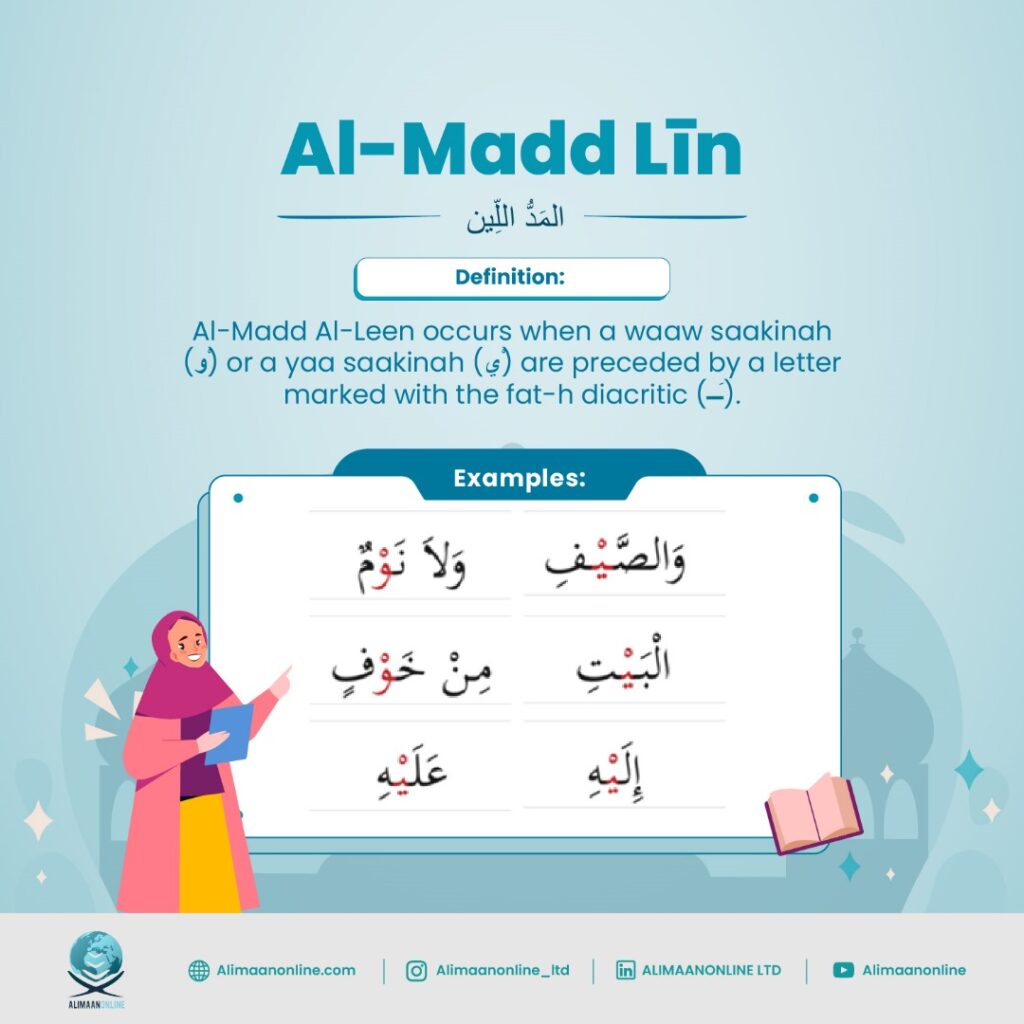Al-Madd Al-Leen, a term integral to the science of Tajweed, refers to a specific type of elongation applied in Quranic recitation. Understanding Al-Madd Līn is crucial for proper pronunciation and beautification of the Quran. This article delves deep into the concept, rules, and application of Al-Madd Līn to enhance your recitation skills.
What is Al-Madd Al-Leen?
المَدُّ اللِّين
Al-Madd Al-Leen is a form of madd (elongation) in Quranic recitation. Al-Madd Al-Leen occurs when a waaw saakinah (وْ) or a yaa saakinah (يْ) are preceded by a letter marked with the fat-h diacritic (ــَـ). This specific elongation is applied to enhance the fluidity and melodious nature of recitation.
The Letters of Al-Madd Al-Leen
Al-Madd Līn involves two specific letters: Waw Sakinah (و) and Yaa Sakinah (ي). We consider these letters leen because of their soft and flexible nature when pronounced.Understanding these letters is fundamental to mastering Al-Madd Līn.
The two letters of Leen (Wau sakinah preceded by fatha and Ya’ sakina preceded by fatha) originate from the Jawf (empty space in the mouth) when encountering Madd Leen.
The Rules of Al-Madd Līn
To correctly apply Al-Madd Al-Leen, one must follow precise rules. These rules dictate when and how the elongation occurs. The primary rule is that the leen letter must be preceded by a fatha. It occurs when a word includes a letter of leen and the reciter chooses to stop on it, resulting in a sukoon (non-vowel) placed on the last letter. In this case, the reciter elongates the Madd for 2, 4, or 6 counts. The sign indicating the presence of Madd Leen requires the letters Waw and Yaa to be marked with sukun and the preceding letter to have a vowel fatha. Madd Leen only applies if the reciter halts the recitation on it. If the recitation continues, it remains as the letter Leen.
Articulation of Al-Madd Līn
The Waw (و) sound is produced by rounding the lips, creating a soft and flowing sound. On the other hand, the Ya’ (ي) sound is created by raising the middle part of the tongue towards the roof of the mouth. Proper articulation of these sounds ensures that the elongation is smooth and melodic.
Learn more: Points of Articulation
Examples of Madd Līn in the Quran
Examining Quranic verses where Al-Madd Līn is applied helps in understanding its practical application. Here are some illustrative examples:
- Continuation without Al-Madd Al-Leen:
- Verse: الْبَيْتَ مَثَابَةً (Al-bayta mathaabatan)
- Explanation: In this example, the conditions of Al-Madd Al-Leen are fulfilled as the harf madd (yaa) is preceded by a fatha. However, we do not stretch this yaa for 2, 4, or 6 counts because the recitation continues onto the next word, mathaabatan. Thus, Al-Madd Al-Leen becomes void.
- Application of Al-Madd Al-Leen:
- Verse: أَهْلَ الْبَيْتِ (Ahla-l-bayti)
- Explanation: Here, after the word bayt, the “jeem” character indicates it is preferable to stop reading. In this situation, we stretch the yaa in bayt for 2, 4, or 6 counts and stop for a breath. More examples include خَوْفٍ (Khawwf) and وَالصَّيْفِ (Al-sayyf).
The Importance of Al-Madd Līn in Tajweed
Al-Madd Līn holds great importance in the field of Tajweed. It is a fundamental aspect of Quranic recitation that helps us connect with and understand the Quran on a deeper level. By mastering the correct pronunciation and rate of harakat, we can truly appreciate the beauty and eloquence of Allah’s words. Madd Leen enhances the recitation of the Quran by adding emotion and accuracy, and with practice, it becomes second nature.
The Conditions for the Occurrence of Al-Madd Līn
- Madd Leen is formed by the presence of the letters Waw Sakinah (وْ) and Yaa Sakinah (يْ).
- These letters must be preceded by a letter that carries the fatha vowel diacritic (ــَـ).
- To properly pronounce Madd Leen, the reciter must pause or stop the recitation after uttering the word that contains the madd. It is important to note that if the recitation continues without a pause, the Madd Leen is considered void and does not apply.
By adhering to these conditions, reciters can ensure accurate and precise recitation of the Quran, adhering to the rules and guidelines of Tajweed.
Common Mistakes in Applying Al-Madd Līn
Many learners make mistakes when applying Al-Madd Al-Leen. Common errors include improper elongation length and incorrect pronunciation of leen letters. Recognizing and correcting these mistakes is crucial for accurate recitation.
Tips for Mastering Al-Madd Al-Leen
To master Al-Madd Al-Leen, consistent practice is essential. Utilizing audio resources and seeking guidance from qualified teachers can significantly improve your skills. Additionally, practicing with specific Quranic verses can help reinforce proper elongation techniques.
Difference Between Madd Arid Lissukun and Al-Madd Līn
Understanding the distinctions between different types of elongations (Madd) in Quranic recitation plays a crucial role in proper Tajweed. Madd Arid Lissukun and Al-Madd Al-Leen are two important types of elongations, each with unique characteristics and rules.
Madd Arid Lissukun
Definition: Madd Arid Lissukun occurs when a reciter stops at the end of a word, and the final letter of that word has a sukoon due to the stopping. This type of elongation can occur with any of the three Madd letters (Alif, Waw, or Yaa).
Conditions:
- A Madd letter (Alif, Waw, or Yaa) must be present.
- The reciter stops at the end of the word, causing the final letter to have a sukoon.
Length: The elongation can be for 2, 4, or 6 counts, depending on the style of recitation and the rules of Tajweed being followed.
Example:
- Word: سُوءٌ (soo’un)
- Explanation: If a reciter stops at the end of this word, the final letter hamzah with a sukoon results in Madd Arid Lissukun.
Read more: Madd Arid Lissukun
Al-Madd Al-Leen
Definition: Al-Madd Al-Leen is a specific type of elongation that occurs with the letters Waw Sakinah (وْ) and Yaa Sakinah (يْ) when they are preceded by a letter carrying a fatha. The elongation happens when the reciter pauses or stops on the word containing these letters.
Conditions:
- Presence of Waw Sakinah (وْ) or Yaa Sakinah (يْ).
- These letters must be preceded by a fatha.
- The reciter must stop after the word containing the leen letter. If the recitation continues without a stop, the Madd Leen is void.
Length: The elongation can be for 2, 4, or 6 counts, similar to Madd Arid Lissukun.
Example:
- Word: خَوْفٍ (Khawf)
- Explanation: When stopping on this word, the Waw Sakinah preceded by a fatha results in Madd Al-Leen.
Key Differences
1-Madd Letters:
- Madd Arid Lissukun: Can involve Alif, Waw, or Yaa. Al-Madd Līn: Only involves Waw Sakinah (وْ) and Yaa Sakinah (يْ).
2-Preceding Vowel:
- Madd Arid Lissukun: The preceding vowel can be any vowel.
- Al-Madd Līn: The preceding vowel must be a fatha.
3-Application:
- Madd Arid Lissukun: Applied when stopping at the end of any word causing the final letter to have a sukoon.
- Al-Madd Līn: Specifically applied when stopping on words with Waw Sakinah or Yaa Sakinah preceded by a fatha.
4-Occurrence:
- Madd Arid Lissukun: Occurs at the end of any word in the Quran when the reciter stops.
- Al-Madd Al-Leen: Occurs within words containing the leen letters under specific conditions.
Conclusion
In conclusion Al-Madd Līn is a fundamental aspect of Quranic recitation that requires understanding and practice. By following the rules and applying the correct techniques, you can enhance your recitation. Mastery of Al-Madd Līn not only beautifies the recitation but also preserves the Quran’s traditional oral legacy.

